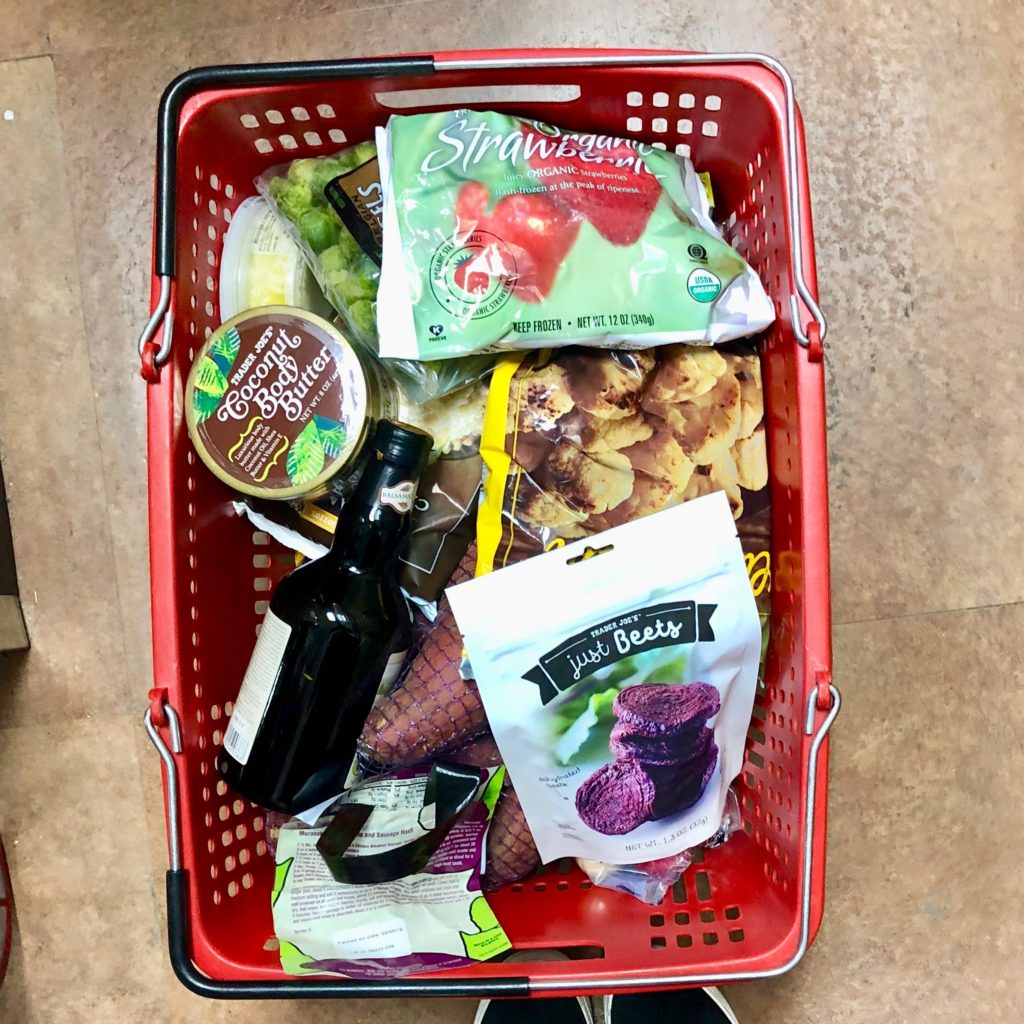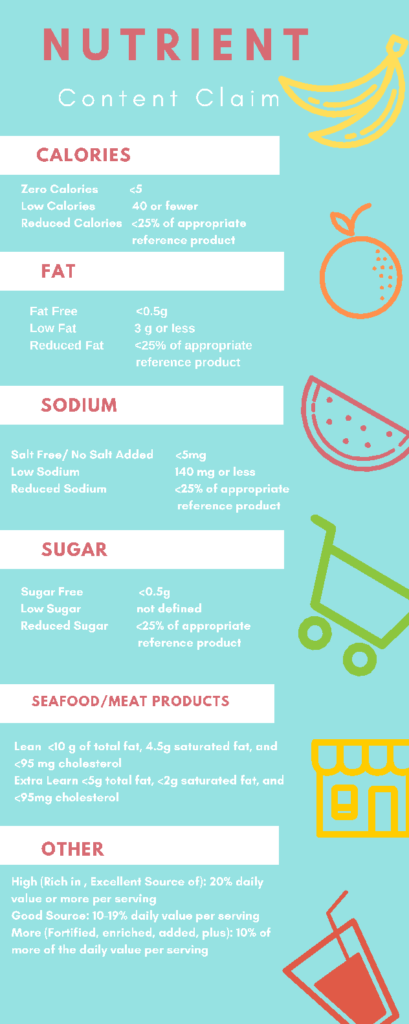Hey guys! In celebration of National Nutrition Month, today, I’m sharing a post from a dietetics student, Kathleen Rovira. I get questions all the time about the path to becoming an RD, and I’ll be real, it was TOUGH but rewarding! What’s cool, though, is that there are so many amazing things you can do as a dietitian. Kathleen is a graduate student with a focus in obesity and nutrition, and today she’s demystifying label-reading.
***
When you’re trying to be health conscious, the grocery store can be overwhelming with its signs and placement of products everywhere fighting for your attention. There are a lot of factors that can influence our food choices and buying behaviors, many that we are unaware of. It can be hard to filter what we should trust and what we should tune out.
Reading a Food Label:
 Reading a food label can be a difficult task and the long list of ingredients that you can’t pronounce is intimidating and scary. There are some key things on food labels that you should know about that may help you with making healthier food choices. A few things you learn about your favorite snack or food may surprise you.
Reading a food label can be a difficult task and the long list of ingredients that you can’t pronounce is intimidating and scary. There are some key things on food labels that you should know about that may help you with making healthier food choices. A few things you learn about your favorite snack or food may surprise you.
- Servings size / Serving per container –
The serving size of a product is the recommended serving size, often measured in cups, pieces, or grams. The servings per container are how many of the recommended serving size there are in the whole package. Many food items may seem like they are packaged in individual serving sizes, but they actually have 3-4 servings. This is where you should start when looking at a Nutrition Facts Label.
- Calories – The number of calories per serving size and the number of calories from fat. The amount of calories you eat depends on how many serving sizes you consumed. If you ate two servings, double the calories, and the nutrients.
- Nutrients – The middle section of the nutrition facts label lists the total fat
(saturated fat and trans-fat), cholesterol, sodium, potassium, total carbohydrate,
dietary fiber, sugar, and protein. The new label will include an added sugar section under total sugars; added sugar includes sugars that have been added during food processing.
Percent Daily Value – Gives you the percentage of a nutrient contained in
one serving in regards to the amount of a nutrient recommended for an average adult on a 2,000 calorie diet. 5% or less is low and 20% or more is high.
- Other Nutrients – includes Vitamin A, Vitamin C, Calcium, Iron, and other vitamins and minerals. Aim to get the recommended amounts for these nutrients.
- Footnote– The last section of the nutrition facts label gives the daily-recommended values for a 2,000 and 2,500 calorie diet. It provides recommended dietary advice, and is not food specific.
How Marketing Influences Our Choices
Repeated exposure through TV programs and advertisements primes our behaviors by portraying positive experiences and positive attitudes towards a type of food, often times junk food or fast food. The more we are exposed to these kinds of stimuli, the more likely we are to create positive attitudes and perceptions towards junk food and fast food. TV programs, commercials, and advertisements often use sensory-related cues to appeal to us which can trigger our thoughts, feelings, and urges towards foods.
The grocery store is flooded with marketing tricks that you may be accustomed to from years of repeated exposure. Nutrient content claims and statements of facts are commonly used for nutrition marketing. A nutrient content claim on a product says that a certain amount of nutrient is present in their product. For example: low in fat or a good source of Calcium. A statement of fact on a food label provides an amount of a nutrient without identifying adjectives such as low, high, etc. For example; 100 calorie pack or 2 grams of carbohydrate per serving.
Sometimes, when we see foods with nutrient content claims or statements of facts, we fall into what we call a “health halo” effect. The health halo causes us to believe that a certain food item is better for us because of the content claims. For example, a food could be labeled “gluten-free” or “Vegan” and be drowning in sodium or sugars; however, the statements of “Vegan” or “gluten-free” can cause consumers to think the food is healthier.
Other marketing tricks use cartoons or popular brands such as Disney characters on food and beverage packages to target kids. Often, kids have developed a connection with that cartoon or character, so they are more likely to pick that food or beverage product. Another dirty trick is that sugary cereals are placed on the shelves in children’s line of sight.
What to look for instead
Shop the outside perimeter of the grocery store first; this is where you can find the unprocessed and healthier foods in the store- fruits, vegetables, dairy, meat, and fish. The center aisles of the grocery are where the processed and junk foods typically are. Try not to buy foods with cartoons or characters on them as these are specifically targeted to children, often times these foods would be considered junk foods. Use the infographics as a nutrient content claim guide when looking at food labels.
Comment below and let me know if you have seen any of these marketing tricks at your local grocery stores.
References:
Guidance for industry: food labeling guide. U.S. Food and Drug Administration website. https://www.fda.gov/Food/GuidanceRegulation/GuidanceDocumentsRegulatoryInformation/ucm2006828.htm.Published January 2013. Updated 09/15/2018 Accessed 02/19/19.
Harris JL, Bargh JA, Brownell KD. Priming effects of television food advertising on eating behavior. Health Psychol. 2009:28(4);404-413.
How to understand and use the nutrition facts label. U.S Food & Drug Administration website. January 3, 2018. Accessed February 8, 2019.
Use the nutrition facts label. National Heart, Lung, and Blood Institute website. February 13, 2013. Accessed February 8, 2019.
Wartella EA, Lichtenstein AH, Boon CS. Front of the package nutrition rating systems and symbols: phase I report. The National Center for Biotechnology Information website. https://www.ncbi.nlm.nih.gov/books/NBK209851/. 2010. Accessed February 21, 2019.
Infographics were created by Kathleen Rovira
Bio: Kathleen Rovira is a graduate student at Northeastern University with a concentration in obesity and nutrition. She received her bachelor’s degree from the University of Alabama with a major in Food and Nutrition. She believes in intuitive eating and does not believe in labeling foods as “good” or “bad”, any food should be eaten in moderation. She also believes that food should not be used as a reward or as a means of punishment, food is to be enjoyed and viewed as a source of nourishment. She has enjoyed her path towards becoming a registered dietitian in the future and looks forward to the next chapter of her journey. Outside of work and school, she enjoys yoga, hiking with her Siberian husky, trying new foods, and traveling. You can connect with her through her Instagram @katrovira.

